Greenhouses make it possible to grow plants longer, protect them from harsh weather, and even produce fresh food throughout the year.
Buying a ready-made greenhouse can be expensive, but there are many ways to build your own without spending much.
By using recycled items, simple materials, or low-cost designs, you can create a greenhouse that fits your space and gardening needs.
In this article, you’ll find 12 cheap and easy DIY greenhouse ideas that are practical, creative, and suited for different types of backyards and gardens.
Benefits of Having a DIY Greenhouse
Building your own greenhouse is about more than just saving money.
A DIY greenhouse offers practical and long-term benefits that can improve your gardening and help you get more from your space.
Extended Growing Season
A greenhouse keeps plants warm and sheltered, which means you can start seeds earlier in spring and continue harvesting later into the fall.
In some regions, it even makes year-round gardening possible.
Protection from Harsh Weather
Strong winds, heavy rain, and early frosts can ruin crops.
A greenhouse provides a controlled environment that shields plants from sudden changes in weather and helps them grow more consistently.
Defense Against Pests
Greenhouses act as a barrier against insects, birds, and small animals that might eat or damage your plants, complementing other natural pest control solutions you can use to keep your garden healthy.
With fewer pests to deal with, you’ll have higher yields and stronger crops.
More Variety of Plants
Because the environment inside is warmer and more stable, a greenhouse allows you to grow plants that might not normally thrive in your climate.
This means you can experiment with herbs, vegetables, or flowers that would otherwise be difficult to grow outdoors.
If you’re curious about options, check out what to grow in a greenhouse.
Cost Savings Over Time
While building a greenhouse requires some effort, it pays off in the long run.
You’ll spend less on buying produce and seedlings, and by using recycled or affordable materials, the initial cost is much lower than purchasing a commercial greenhouse.
12 Cheap and Easy DIY Greenhouse Ideas
There are many ways to build a greenhouse without spending much money.
Some designs use recycled materials like old windows or CD cases, while others rely on simple frames made from wood or PVC.
Whether you need a small structure for seedlings or a larger setup for vegetables, these ideas show how you can create a greenhouse that fits your space, budget, and gardening goals.
1. Plastic Bottle Greenhouse
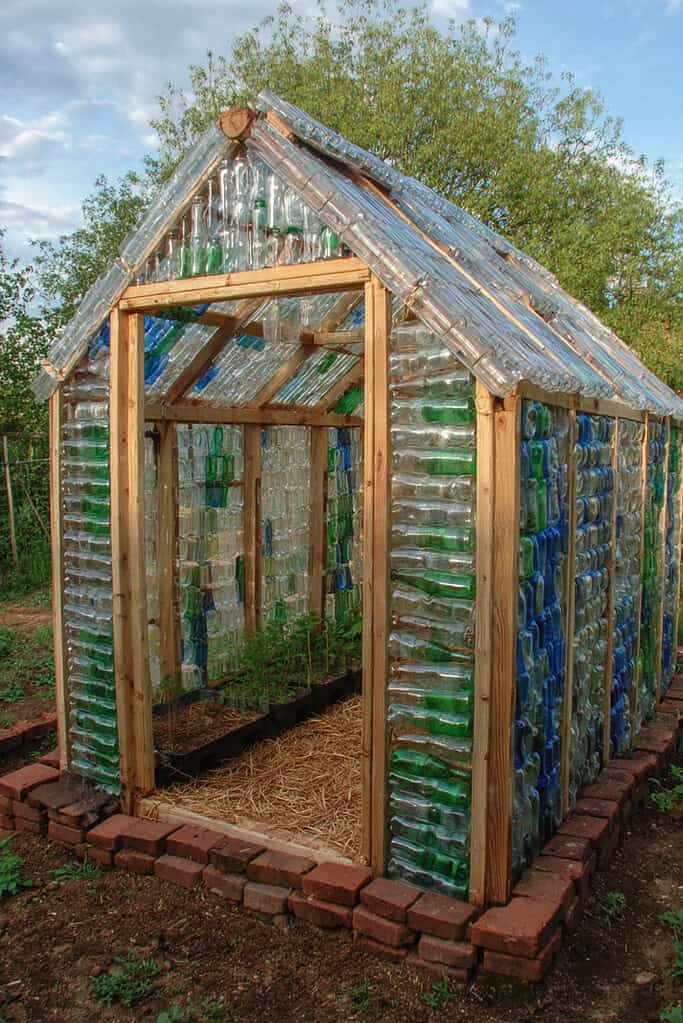
A plastic bottle greenhouse is a clever way to recycle hundreds of clear plastic bottles into a sturdy structure.
The bottles are cut, cleaned, and stacked together to form walls that let in plenty of sunlight while also providing insulation.
The frame can be made from wood or metal, with the bottles threaded onto sticks or wires to create panels.
This type of greenhouse takes time to assemble but is very low-cost if you can collect enough bottles.
It’s ideal for gardeners who want an eco-friendly project that reduces waste while creating a durable and functional greenhouse.
2. Little Window Greenhouse
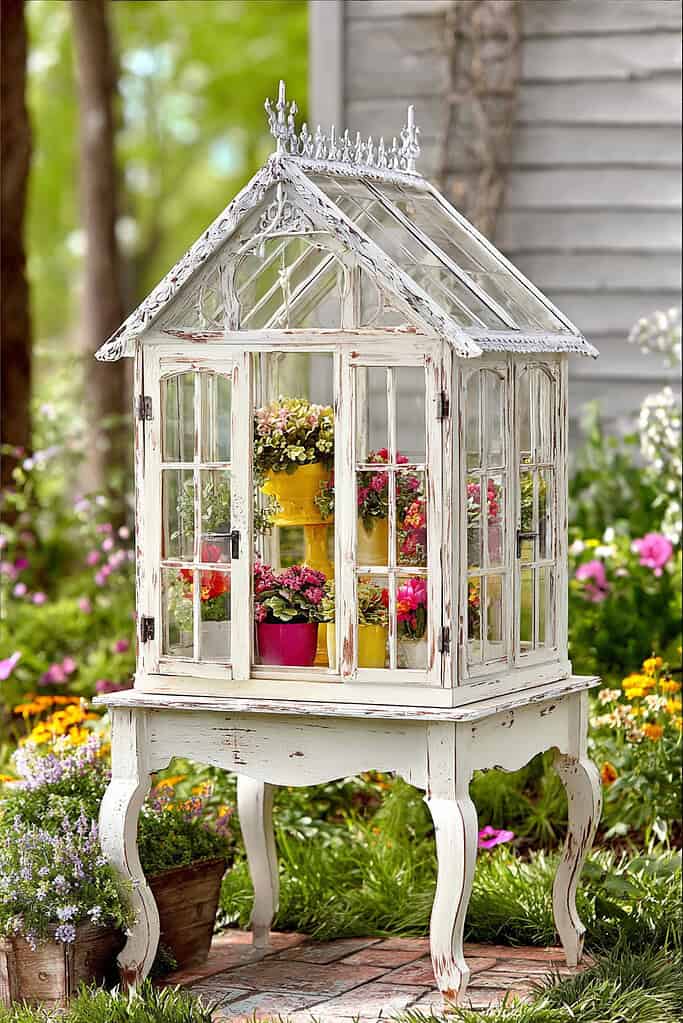
This design is a smaller version of the recycled window greenhouse, making it a perfect option for beginners or for those with limited space.
Made with just a few thrifted windows, it can hold a handful of plants while doubling as a decorative element in your yard.
Some versions are built on a table, which is especially useful in areas that experience snow, keeping the greenhouse raised and protected from ground moisture.
It’s a simple project that can be expanded over time by adding more windows as your garden grows.
3. Repurposed CD Case Greenhouse
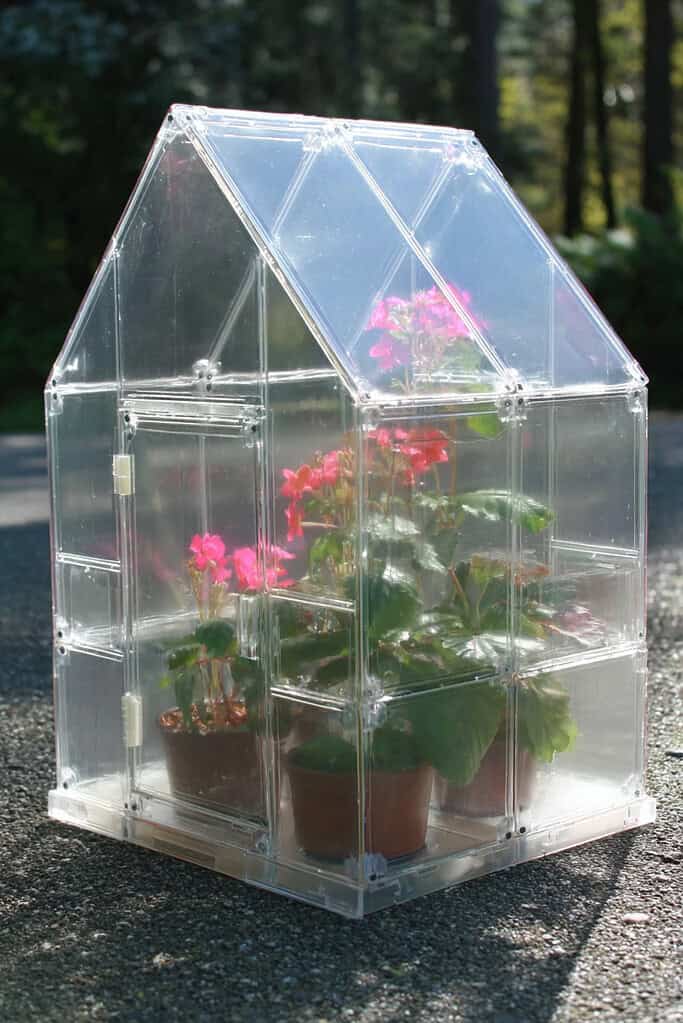
If you have a stack of old CD cases lying around, they can be repurposed into a mini greenhouse.
About 40 cases are enough to create a small box-shaped structure that lets in plenty of light while keeping seedlings safe from the elements.
This project is lightweight and extremely inexpensive, relying mostly on glue or hinges to connect the plastic squares.
It’s best suited for small plants or as a starter greenhouse, but it’s also a creative way to reuse plastic that would otherwise go to waste.
4. DIY Rustic Window Greenhouse

For gardeners who value both function and appearance, a rustic window greenhouse is a perfect choice.
Built from vintage or salvaged windows, this design creates a structure that looks as charming as it is useful.
The detailed wood framing and aged glass give it a cottage-like feel, making it a highlight in any backyard and a great starting point if you’re looking for simple backyard farm ideas.
While it can be built in a weekend, the result is a sturdy and attractive greenhouse that keeps plants safe while adding character to your garden.
5. Cold Frame Greenhouse
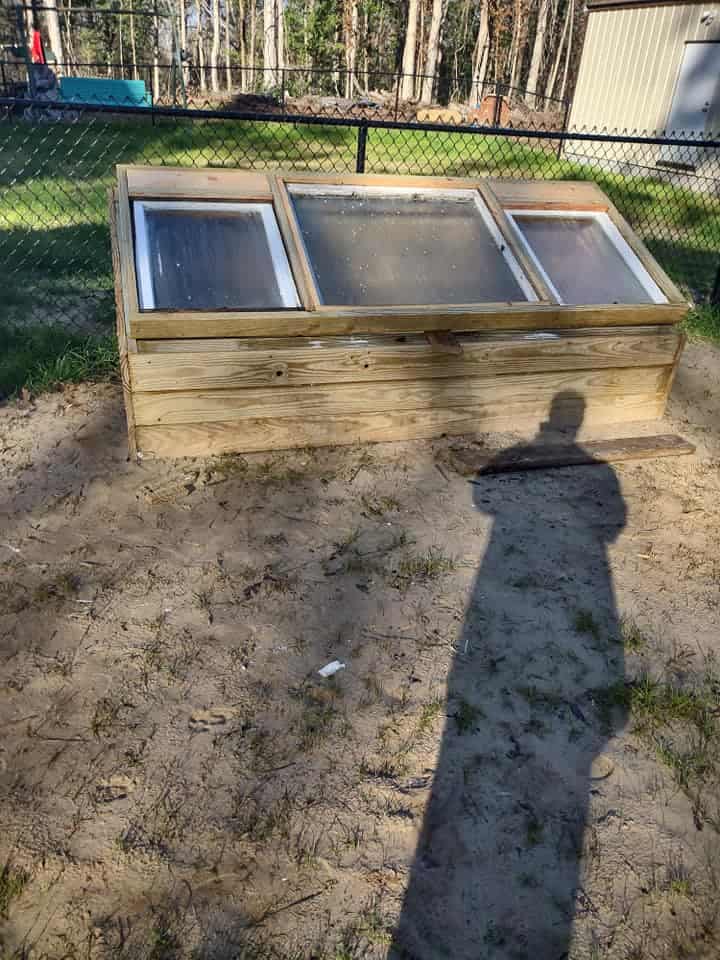
A cold frame is one of the simplest and cheapest ways to create a greenhouse-like environment. It’s usually built with a small wooden box frame topped with a clear lid made from glass or plastic.
The lid captures sunlight and traps warmth, protecting seedlings or cool-season crops from frost.
Cold frames are easy to build using scrap wood and an old window or sheet of plastic, and they fit well in small yards or even on patios.
They’re perfect for extending the growing season in spring and fall without the need for a large structure.
6. Polythene Greenhouse

A polythene greenhouse is built with a lightweight wooden frame, often using 2×4 studs, and then covered with durable polythene sheeting.
It’s one of the cheapest types of greenhouses to construct and can be adapted to fit almost any backyard space. Since the frame is simple, the design is easy to modify or expand later.
However, it’s best suited for regions with mild weather, as it may not hold up well in areas with heavy snow or strong winds.
For seasonal gardening or beginners, it offers a straightforward and affordable way to get started.
7. Arched PVC Greenhouse
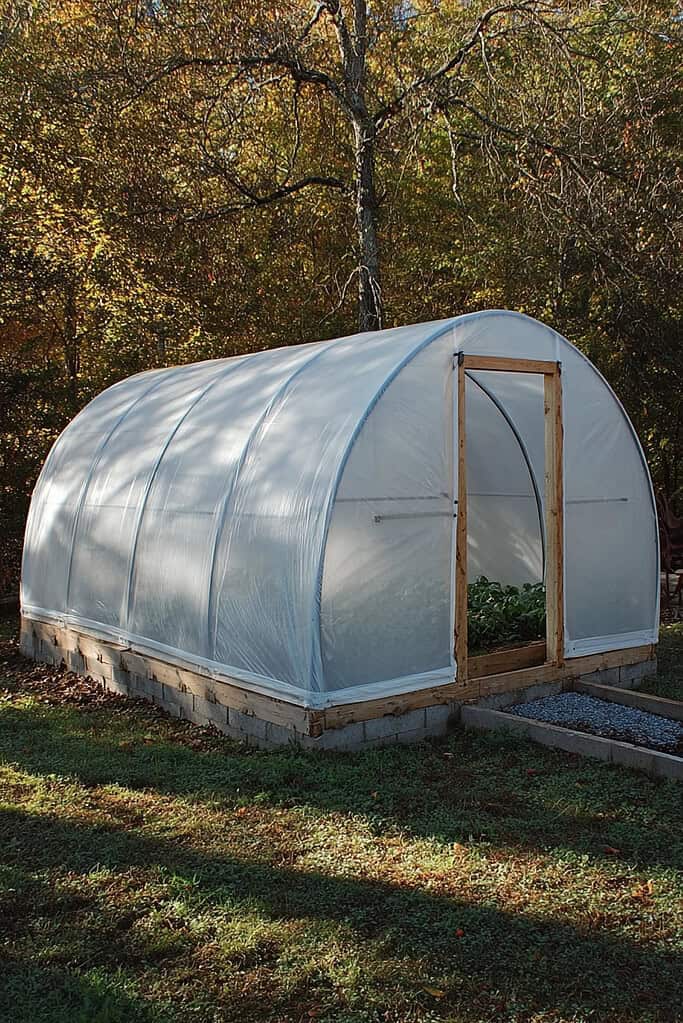
An arched PVC greenhouse is one of the easiest and most affordable structures to build.
Using flexible PVC pipes to create a curved frame, this design is then covered with plastic sheeting to form a protective enclosure. It usually includes a simple door at each end for easy access.
The arched shape gives it good height for taller plants and allows plenty of light inside. This option is ideal for beginners who want to try greenhouse gardening without investing much money or time.
8. Budget Hoop Garden House

A hoop garden house is a smaller version of a PVC greenhouse, made to fit over raised beds or garden boxes.
The hoops are created from PVC pipe or similar flexible material and then covered with plastic or floating row covers.
This type of greenhouse is excellent for protecting plants from light frost, heavy rain, or pests.
Since it’s small and lightweight, it should be placed in a sheltered spot to prevent wind damage. Similar to a lean-to greenhouse, it’s perfect for extending your growing season in a small space.
It’s a budget-friendly choice for gardeners who want to extend their growing season in a simple way.
9. DIY 10-Foot Small Greenhouse

This design is a compact greenhouse with a classic pitched roof and a door, measuring around ten feet in length.
It provides enough space for multiple plants while still fitting comfortably in a small backyard. Built from basic lumber and clear plastic panels or sheeting, it offers durability while keeping costs low.
The size can be adjusted if more space is needed, but even the standard plan gives gardeners a reliable structure to protect plants and grow a variety of crops.
10. GeoDome Greenhouse

A GeoDome greenhouse uses a geometric dome shape made from interlocking parts to create a strong and lightweight structure.
Its design distributes weight evenly, making it stable in heavy winds or snow. The many angled panels allow light to reach plants from all directions, creating an excellent growing environment.
Because of its strength and shape, it usually doesn’t require a permit. While it takes a little more planning to build, it’s a long-lasting option for gardeners in areas with challenging weather.
11. DIY Barn Greenhouse

The barn-style greenhouse combines function with a classic look.
Built with a sturdy frame, corrugated metal, and greenhouse plastic, it provides plenty of room for taller plants and good ventilation.
The sloped roof helps rain and snow slide off easily, making it more durable than lighter designs.
Many DIY builders follow detailed plans that include step-by-step diagrams, making the process easier even for beginners.
This greenhouse works well for gardeners who have extra space and want a structure that will last for years.
12. DIY 16-Foot Greenhouse

For those with larger gardens, a 16-foot greenhouse is a spacious option that can support year-round vegetable growing.
Despite its size, it can still be built on a budget using simple materials like lumber and plastic sheeting.
The straightforward design allows for quick assembly while still offering enough room for a wide variety of plants.
It’s a good choice for homesteaders or serious gardeners who want to increase food production without spending the high cost of a commercial greenhouse
Curious About Raised Bed Greenhouses?
If you’re wondering how a compact, elevated greenhouse can improve your gardening, check out our guide on why gardeners need a raised bed greenhouse. It explains the benefits, ideal designs, and tips for getting started, whether you have a small backyard or limited space.
How to Choose the Best DIY Greenhouse for Your Needs
Not every greenhouse design works for every gardener. Before starting your project, think about what you need most and which design fits your situation.
Here are the main factors to consider:
1. Space Available
- Small yards or patios are better suited for compact designs such as the Little Window Greenhouse or the Budget Hoop Garden House.
- Larger spaces can handle bigger builds like the Barn Greenhouse or the 16-Foot Greenhouse.
2. Climate and Weather
- Mild climates can make good use of lightweight options like polythene or PVC greenhouses.
- Harsh winters or windy areas require stronger structures such as the GeoDome or barn-style designs.
3. Materials on Hand
- If you have access to salvaged windows, doors, or lumber, a recycled-material build may cost you almost nothing.
- If you don’t have recycled supplies, PVC pipe and plastic sheeting are affordable and easy to find at hardware stores.
4. Gardening Goals
- For seedlings or a handful of plants, small projects like the CD Case Greenhouse are enough.
- For year-round vegetable growing or larger plant collections, consider larger designs like the 10-Foot, Barn, or 16-Foot greenhouse.
By matching the design to your space, climate, materials, and goals, you’ll build a greenhouse that works well for your needs without spending extra time or money.
If you’d prefer a ready-made option, you might also want to explore some recommended greenhouse kits that balance affordability with convenience.
Start Building Your Own DIY Greenhouse Today
Creating a greenhouse doesn’t have to be expensive or complicated.
With the 12 ideas we’ve covered, you can choose a design that matches your space, budget, and gardening goals.
Whether you want a small project made from recycled windows or a larger structure that can handle year-round growing, there’s a greenhouse plan for every gardener.
A DIY greenhouse not only protects your plants but also helps you grow fresh food for your household while saving money.
The best part is that you can start small and expand later as your gardening needs grow.
Which DIY greenhouse idea do you want to try first? Comment down below and share your favorite!
FAQs
1. How do I keep a DIY greenhouse warm in winter?
You can insulate with bubble wrap, add water barrels to store heat during the day, or use small heaters for extremely cold nights.
2. What’s the best plastic to use for covering a greenhouse?
UV-resistant greenhouse plastic or heavy-duty polythene sheeting is the most reliable. Avoid regular plastic as it breaks down quickly under sunlight.
3. How do I stop condensation inside a greenhouse?
Good ventilation is key. Add vents, leave small gaps for airflow, and avoid overwatering plants to reduce moisture buildup.
4. Can I build a greenhouse without a foundation?
Yes, many small and medium-sized DIY greenhouses can be built directly on the ground. For larger structures, a simple foundation of gravel, wood, or concrete improves stability.
5. How often should I clean a greenhouse?
Clean at least once a year, ideally before the new growing season. Wash panels or plastic to improve light transmission, and disinfect surfaces to prevent pests and diseases.
Ready To Transform Your Garden?
Are you looking for the best way to layout your garden beds? Maybe you're feeling a bit stuck on how to make the most of your space?
We’ve got you covered! Check out our 101+ Garden Bed Layout Ideas for your next raised bed project. This guide is filled with creative and practical ideas that can help you design a garden that fits your style, whether you’re just starting out or have been gardening for years.
Get your copy today and get inspired to bring your gardening dreams to life.

